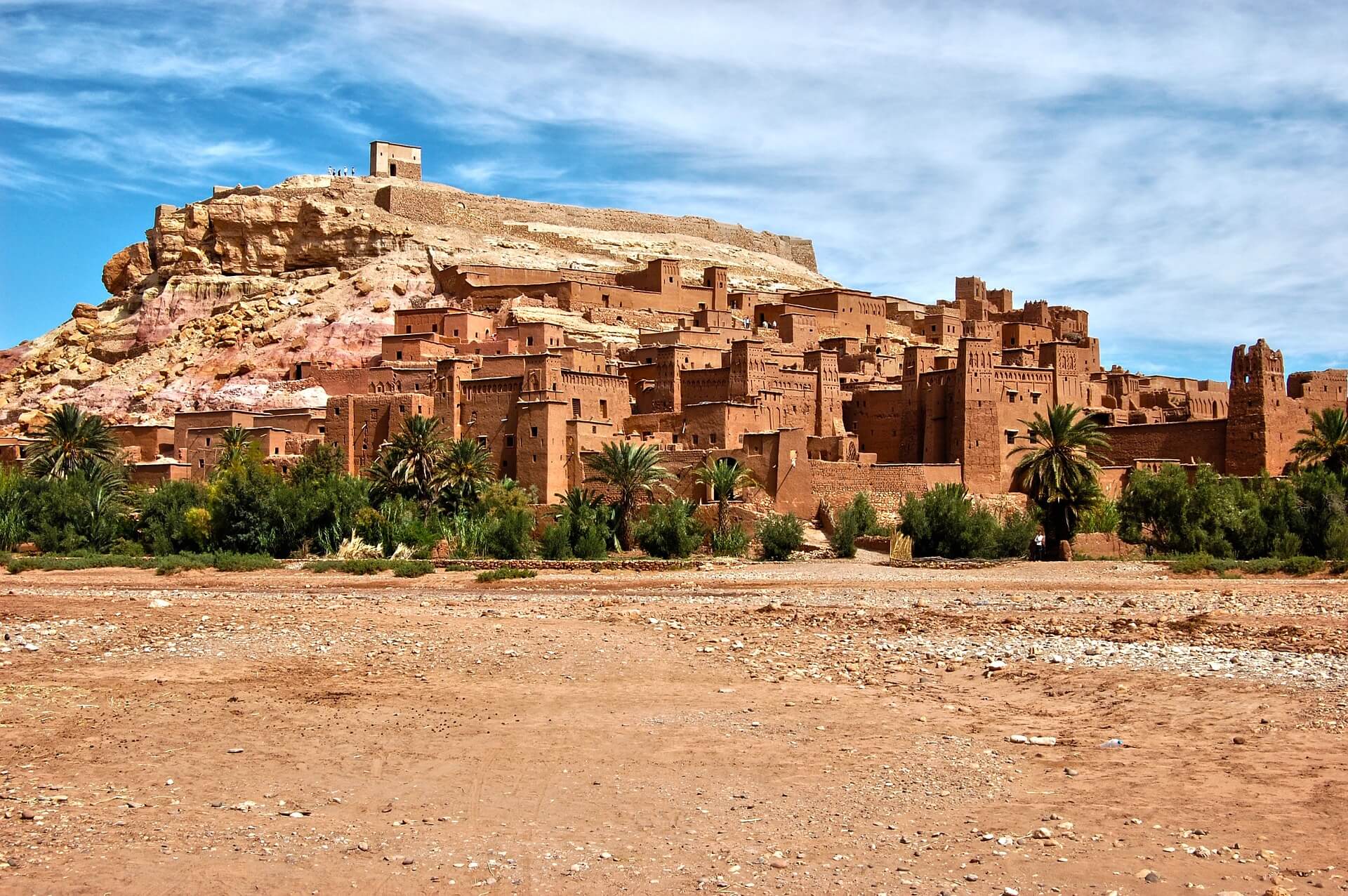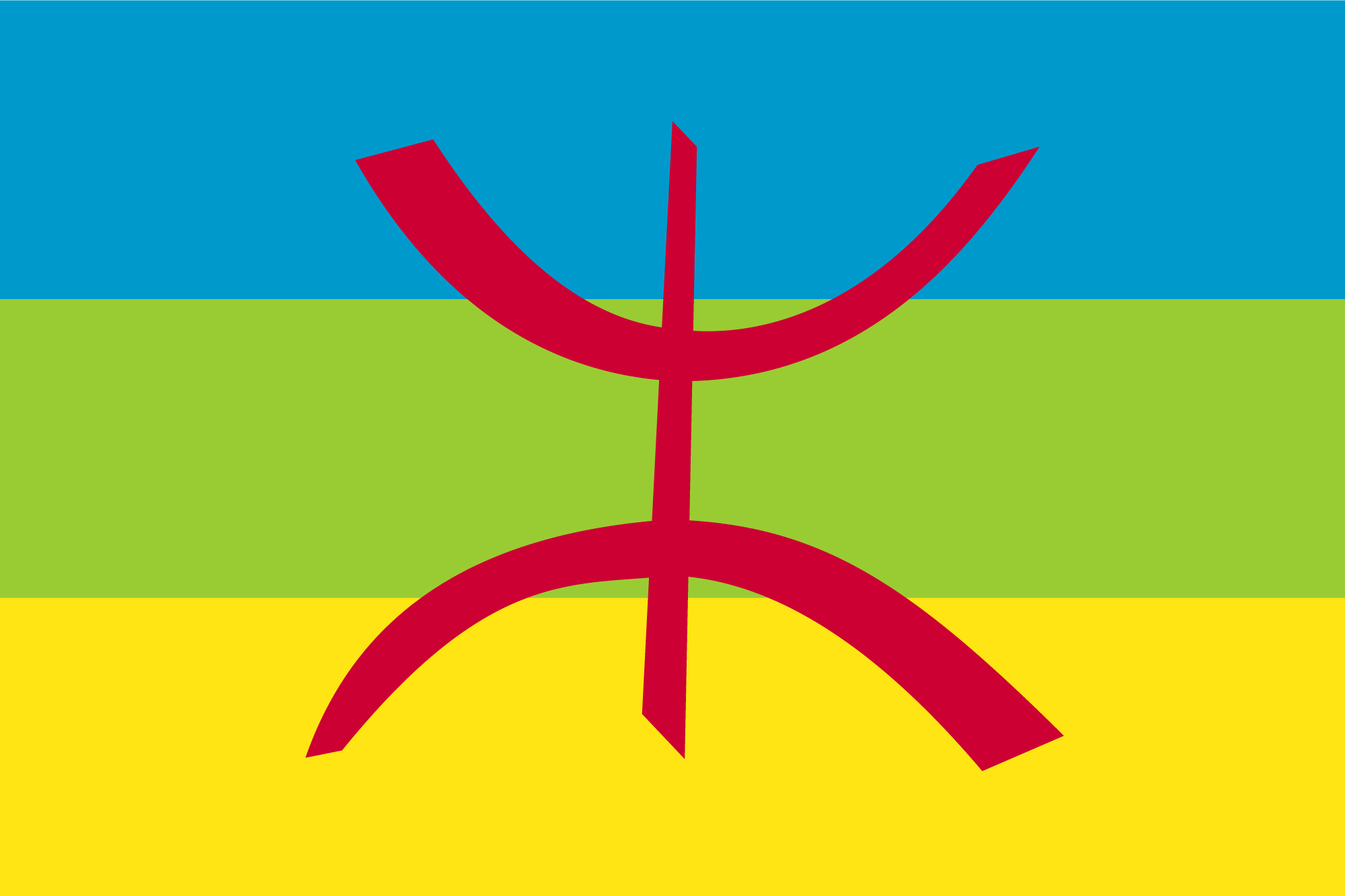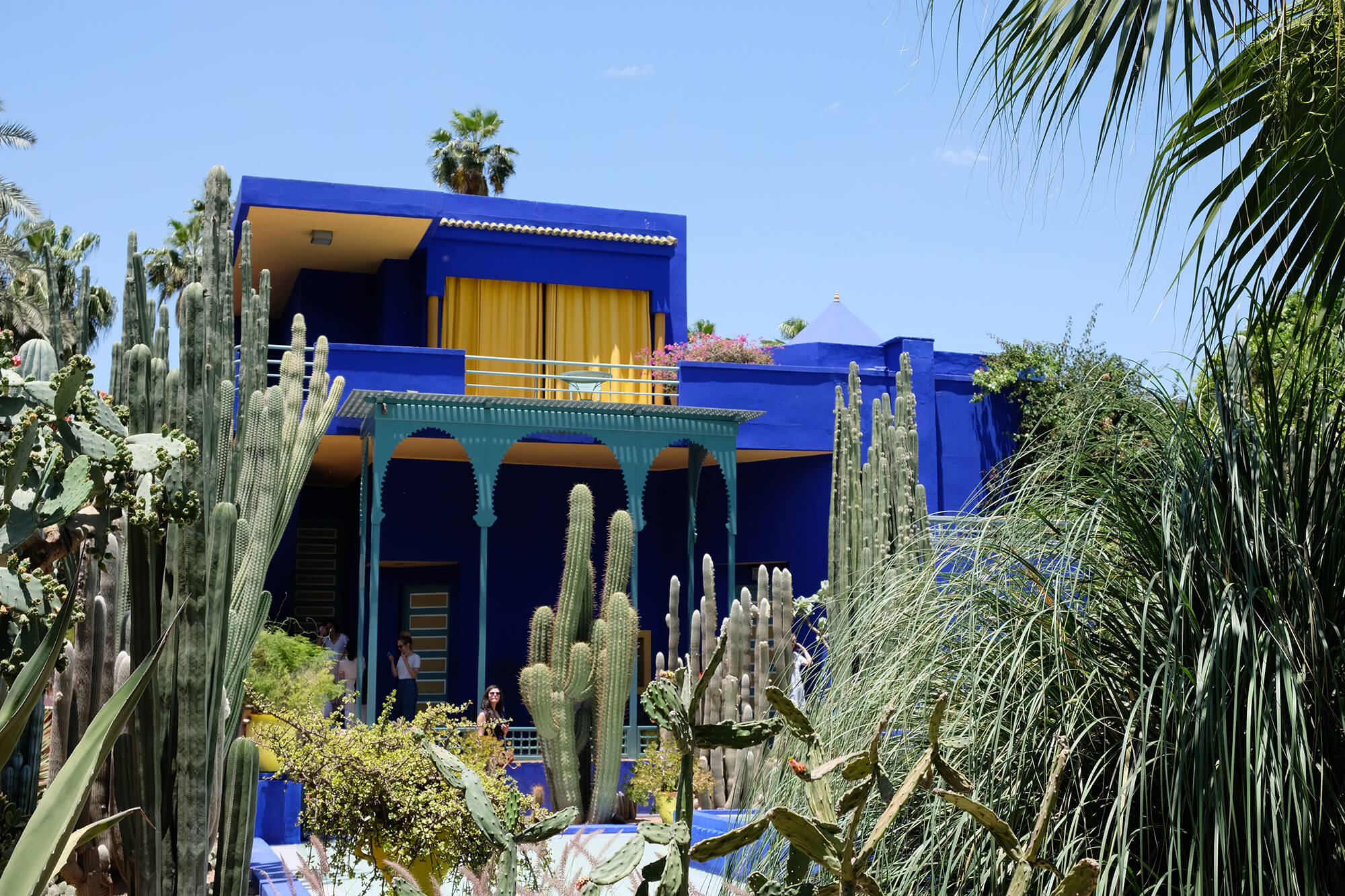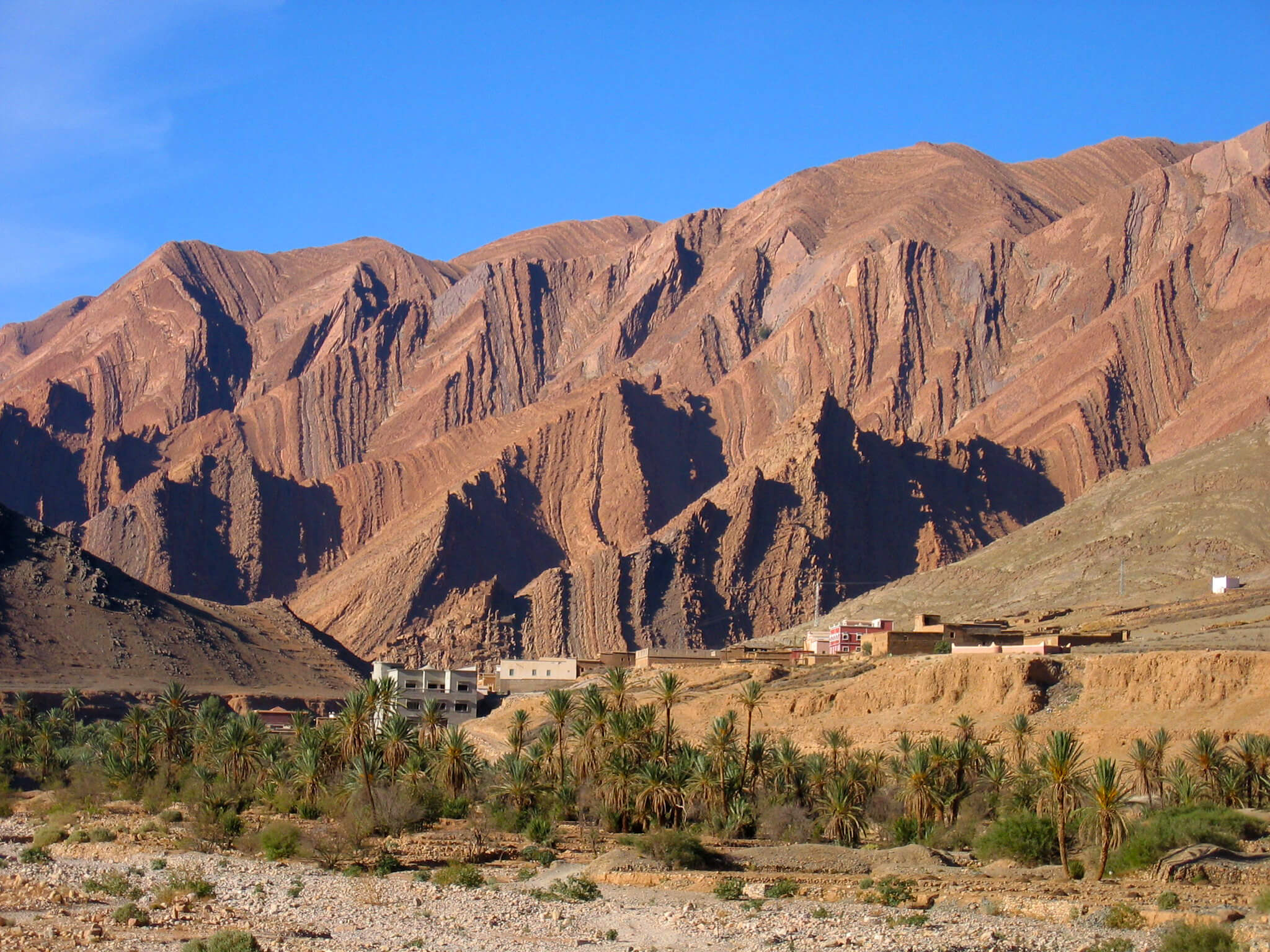Aromatic and exotic, Moroccan cuisine combines with multi-cultural influences to create savory and authentic dishes. From traditional to street food and sweets, here’s a look at some of Morocco’s most popular and delicious culinary creations.
The cuisine of Morocco is a reflection of its long and diverse history — a delicious blend of Amazigh (Berber), Arab, Andalusian, Jewish, and Mediterranean influences. Each dish tells a story, shaped by trade routes, nomadic traditions, and centuries of culinary creativity.
From slow-cooked tagines to delicate pastries dripping with honey, Moroccan food is both aromatic and deeply satisfying. It’s a cuisine that celebrates balance — between sweet and savory, warmth and freshness, tradition and innovation.
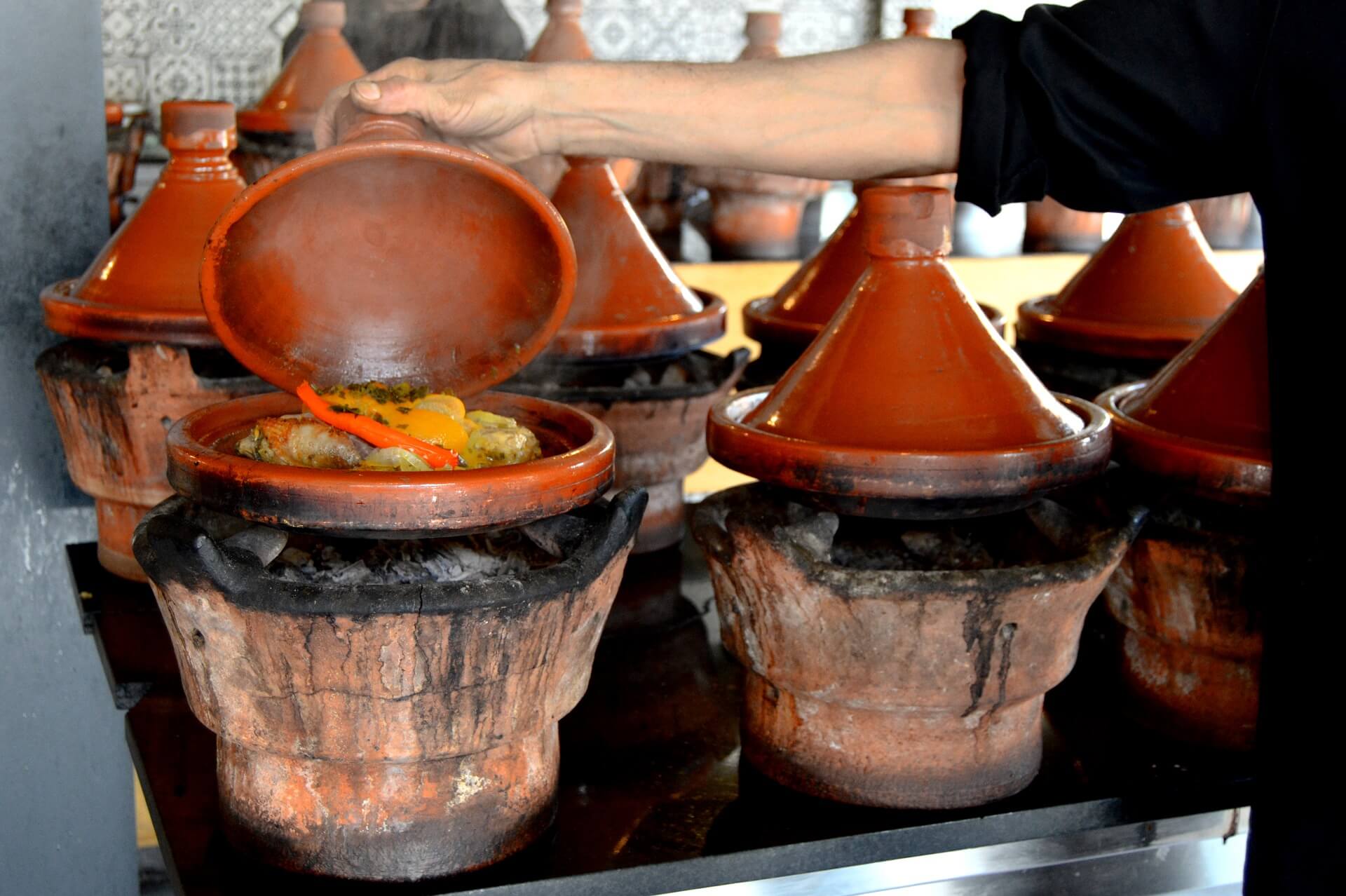
Traditional and Popular Dishes from the Cuisine of Morocco
Tagine
A tagine is both a clay cooking pot and the stew prepared in it. The unique conical lid traps steam, allowing ingredients to cook slowly and tenderly, blending spices into rich, aromatic sauces. Common varieties include chicken with preserved lemon and olives, lamb with prunes, or chicken with apricots — each offering a perfect balance of sweet and savory flavors.
Couscous
Couscous, originally from Morocco, is made from steamed semolina grains that turn soft and fluffy when cooked. Traditionally served on Fridays, it’s topped with tender meat, vegetables, and a light broth that soaks into every grain. The result is a comforting, fragrant dish that symbolizes Moroccan hospitality and family unity.
Bastilla
Bastilla (or pastilla) is a masterpiece of Moroccan fusion cooking — a pie that layers sweet and savory in perfect harmony. Thin sheets of pastry are filled with shredded chicken or pigeon, almonds, eggs, cinnamon, and sugar, creating a crispy, golden crust dusted with powdered sugar. The contrast of textures and flavors makes it unforgettable.
Fish Chermoula
Fish Chermoula showcases Morocco’s coastal flavors with its vibrant herbal marinade. Made from parsley, coriander, garlic, lemon juice, cumin, and paprika, this sauce transforms grilled or baked fish into a tangy, zesty delicacy. Popular choices include sardines, mackerel, and monkfish, freshly caught from the Atlantic.
Kefta
Kefta, or Moroccan meatballs, are made from ground lamb or beef mixed with onions, cumin, paprika, and herbs. They’re often grilled over open flames or simmered in a spicy tomato sauce with eggs on top. Whether served with couscous or bread, kefta is pure Moroccan comfort food.

Soups and Salads
Harira
Harira is Morocco’s traditional soup — hearty, flavorful, and deeply nourishing. Made with tomatoes, lentils, chickpeas, and lamb, it’s gently spiced with cinnamon, ginger, and turmeric. It’s especially enjoyed during Ramadan, when it’s served at sunset to break the fast, accompanied by dates and chebakia sweets.
Bissara
Bissara is a thick and creamy soup made from fava beans, olive oil, and garlic. Popular as a breakfast dish, it provides warmth and energy for the day ahead. Locals often drizzle it with olive oil and sprinkle paprika or cumin on top before dipping bread into the bowl.
Zaalouk
Zaalouk is a smoky, cooked eggplant and tomato salad that bursts with Mediterranean flavor. It’s seasoned with garlic, paprika, and olive oil, served warm or cold with fresh khobz (bread). Simple yet addictive, it’s a staple side dish across Morocco.
Bakoula
Bakoula is made with the leaves of the mallow plant, steamed and sautéed with olive oil, garlic, lemon, and preserved olives. Its tangy, earthy flavor makes it both nutritious and satisfying. Often enjoyed cold, it’s a traditional vegetarian favorite.
Choukchouka
Choukchouka (also known as shakshuka) combines roasted bell peppers, tomatoes, garlic, and chili for a bright, zesty salad or dip. It’s versatile — eaten hot or cold — and pairs perfectly with bread or as a side to grilled meat. Every bite is bursting with smoky sweetness and spice.
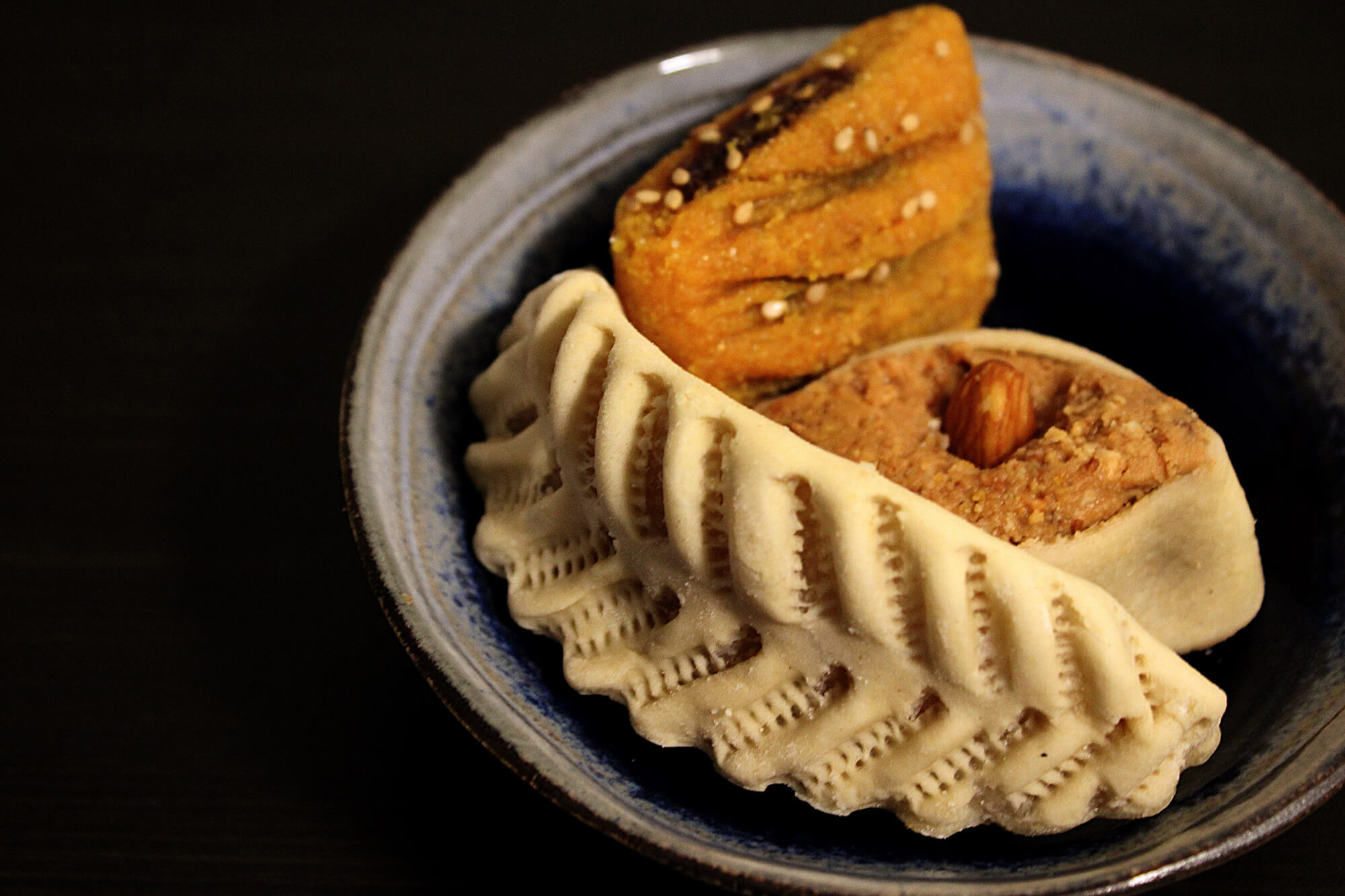
Desserts
Generally, Moroccans tend to eat fruit for dessert but sometimes they give in to their sweet tooth and indulge! Moroccan desserts are incredibly delicious and unique. Sweet, savory and often sticky, you will want to try them all!
The most common ingredients include almonds, orange blossom water and honey. During the Muslim holiday of Ramadan, special desserts are prepared to celebrate, but anytime is a great time to enjoy dessert.
Makrout
Makrout are diamond-shaped semolina cookies filled with sweet date paste and flavored with orange blossom water. After being fried to a golden crisp, they’re dipped in honey for a glossy, aromatic finish. They’re a favorite during festive seasons and tea time.
Kaab el Ghazal (Gazelle Horns)
These crescent-shaped pastries, known as Kaab el Ghazal, are stuffed with almond paste, cinnamon, and orange blossom water. The pastry shell is thin and delicate, often dusted with powdered sugar or glazed with honey. Elegant and aromatic, they’re a symbol of Moroccan refinement.
Chebakia
Chebakia are flower-shaped cookies deep-fried until golden and then drenched in honey and sesame seeds. Their sticky sweetness and crunch make them especially beloved during Ramadan. Every bite offers a burst of floral and spiced notes.
Ghoriba
Ghoriba are shortbread-style cookies made with almonds or walnuts, flavored with honey and a hint of cinnamon. Crisp on the outside and chewy inside, they melt in your mouth and pair beautifully with mint tea.
Ktefa (Milk Bastilla)
Ktefa, also called Milk Bastilla, is a rich dessert of layered pastry filled with almonds and custard cream. Dusted with cinnamon and sugar, it’s both crunchy and creamy. Served during celebrations, it perfectly captures Morocco’s love for luxurious desserts.
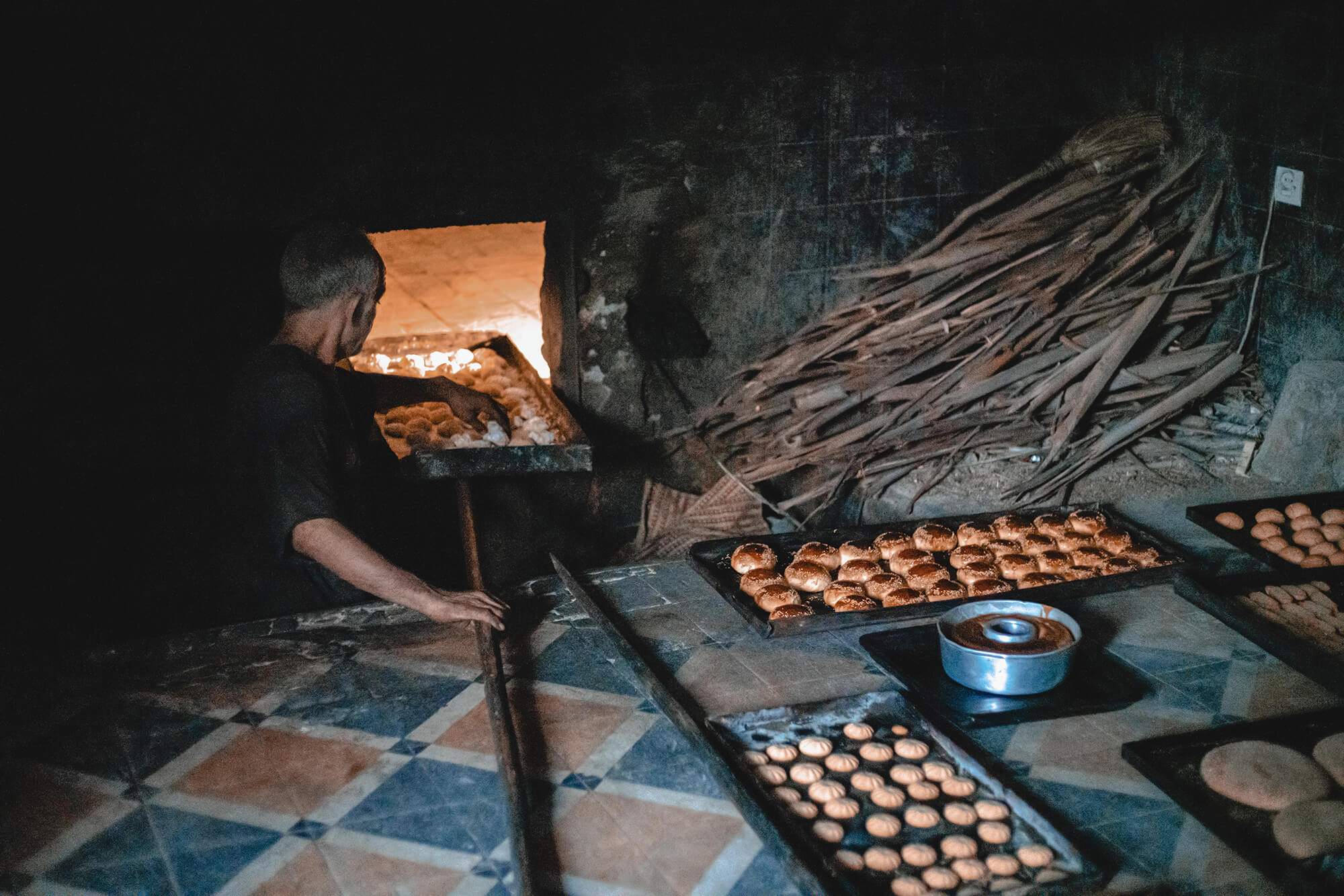
Breads
Bread is a staple at every meal in Morocco and there are several, delicious varieties to try. Here are a few of the most common:
Khobz
Khobz is Morocco’s everyday bread — round, hearty, and perfect for scooping up stews and salads. It’s baked daily in communal ovens and can be flavored with sesame or anise seeds.
Msemmen
Msemmen is a layered, flaky flatbread that’s pan-fried and often enjoyed for breakfast. It’s delicious with butter, jam, or honey — and just as good savory with cheese or olive oil.
Krachel (Brioche Rolls)
Krachel are soft, sweet Moroccan brioche rolls sprinkled with sesame seeds. Lightly scented with anise and orange blossom water, they’re a favorite for tea or afternoon snacks.
Beghrir
Beghrir are soft, spongy pancakes full of tiny holes that soak up honey and butter. Known as “the thousand-hole crepes,” they’re served warm and sweet for breakfast or dessert.
Medfouna (Berber Pizza)
Medfouna, often called Berber Pizza, is a stuffed bread originating from Rissani near the Sahara Desert. It’s filled with spiced meat, onions, and herbs — a delicious portable meal that’s baked until crisp and golden.
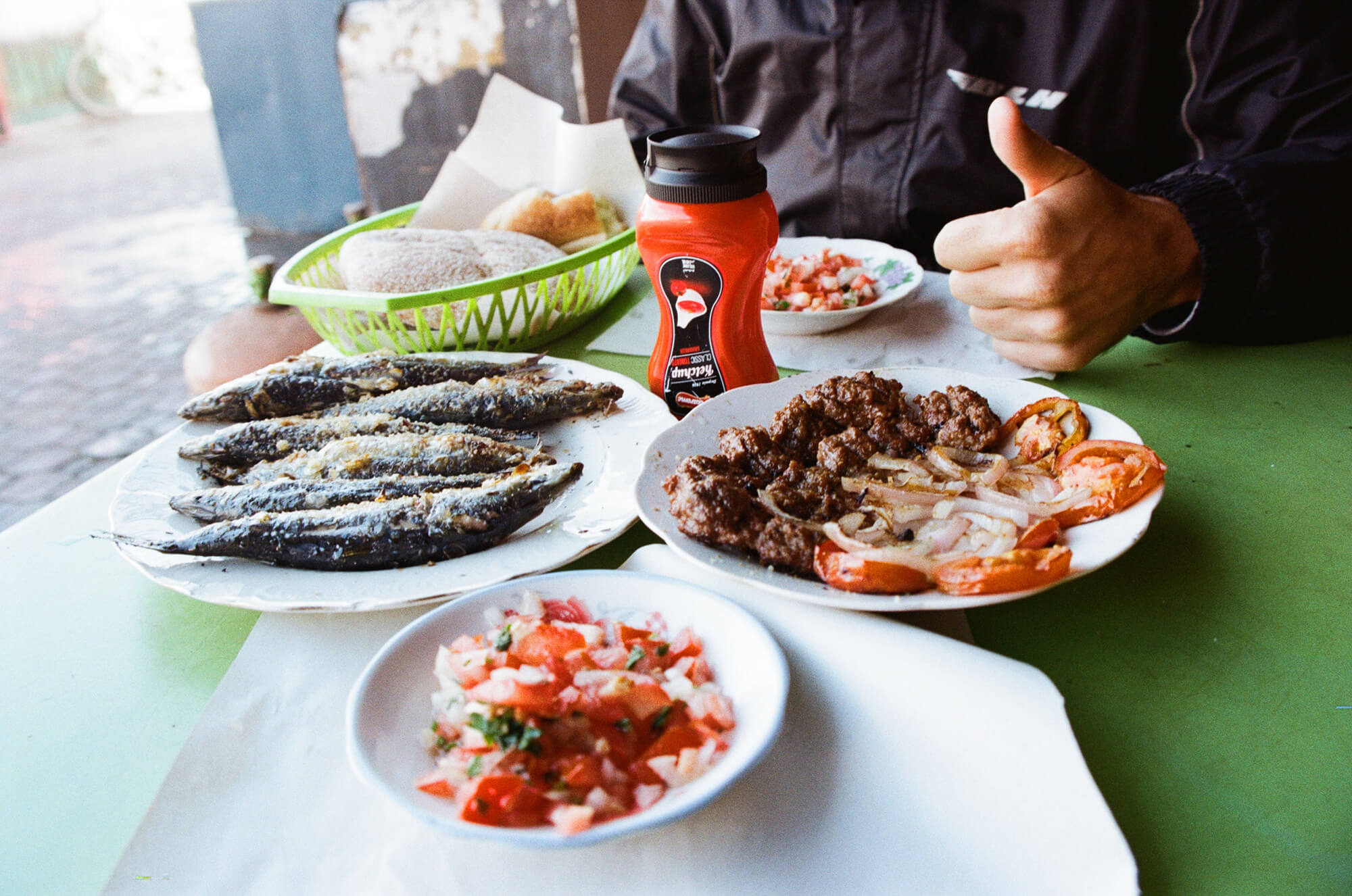
Street Foods
Sardines
Morocco is the world’s largest exporter of sardines, and locals eat them daily — grilled, fried, or stuffed with chermoula. Their freshness and bold flavors make them a street food classic that captures Morocco’s coastal spirit.
Makouda
Makouda are small potato fritters, crispy outside and soft inside, often sold by street vendors. Served with harissa or spicy tomato sauce, they’re an affordable and comforting snack loved by all ages.
Babbouche
Babbouche is Morocco’s famous snail soup, simmered in a fragrant broth of herbs, pepper, and anise. Locals drink it steaming hot from bowls — an adventurous yet flavorful treat.
Merguez
Merguez are spicy lamb or beef sausages grilled over charcoal and served with bread or fries. Their smoky aroma fills the air in Marrakech’s night markets and coastal towns alike, making them irresistible to food lovers.
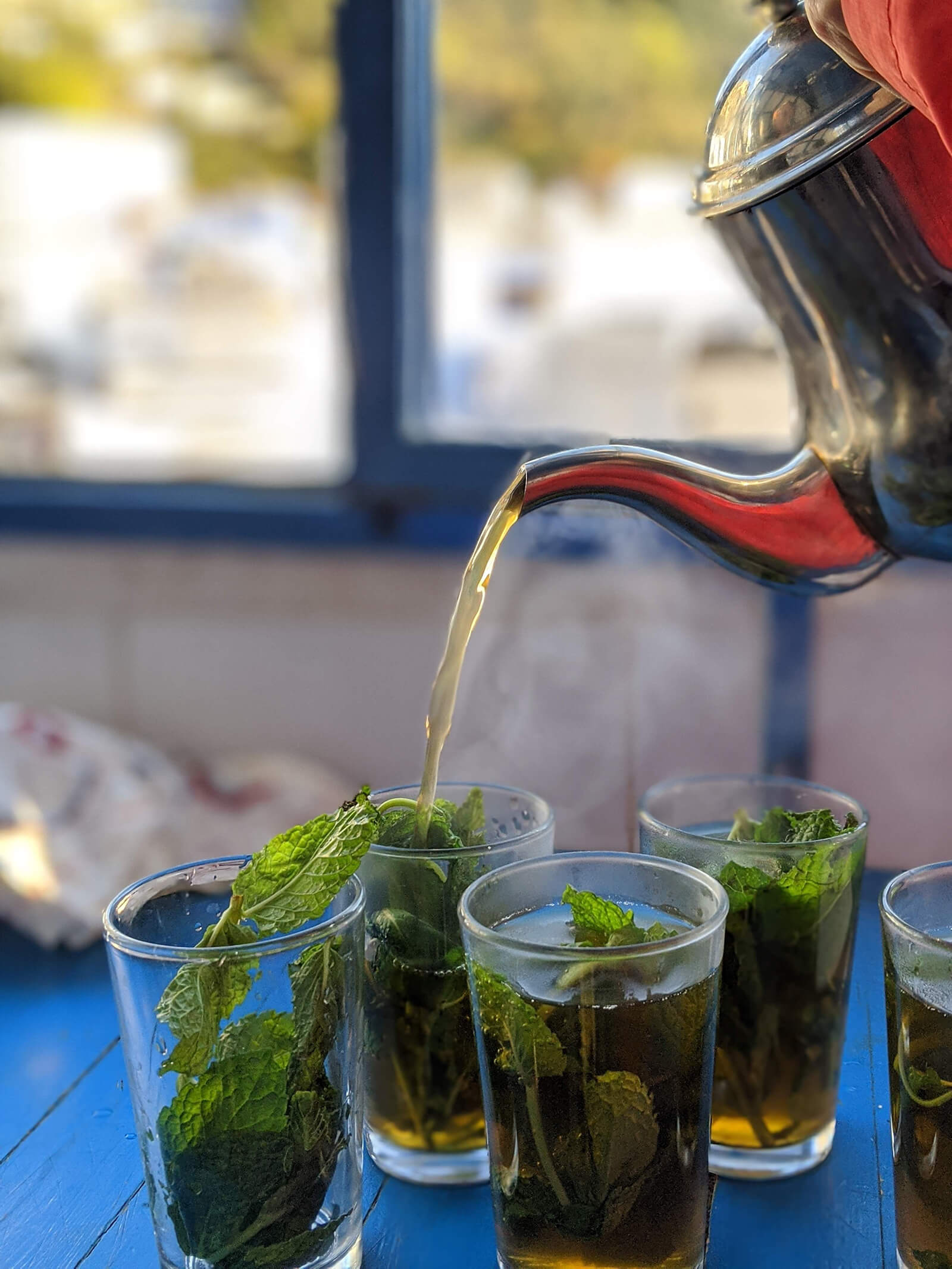
Beverages
Mint Tea
Known as Atay, Moroccan mint tea is the drink of hospitality — green tea infused with fresh mint and plenty of sugar. It’s poured from a height to create foam and is served all day long as a gesture of friendship and warmth.
Almond Milk (Sharbat Billoz)
Sharbat Billoz is a traditional almond drink blended with milk, sugar, and orange blossom water. Served cold, it’s refreshing, nourishing, and a Ramadan favorite for breaking the fast.
Fresh Fruit Juices
Morocco’s markets overflow with seasonal fruits — pomegranates, oranges, watermelons, and grapes. Freshly squeezed juices are sold everywhere, often enhanced with cinnamon or a splash of floral water for a fragrant twist.
Arabic Coffee
Moroccan Arabic coffee is dark, bold, and served without milk, often alongside sweets. It’s enjoyed slowly, symbolizing relaxation and connection — especially in traditional cafés.
Alcohol
Although Morocco is a Muslim country, alcohol is available in licensed hotels, restaurants, and bars. It’s typically consumed discreetly and never in public spaces. Moroccan wines and beers are gaining recognition internationally for their quality.
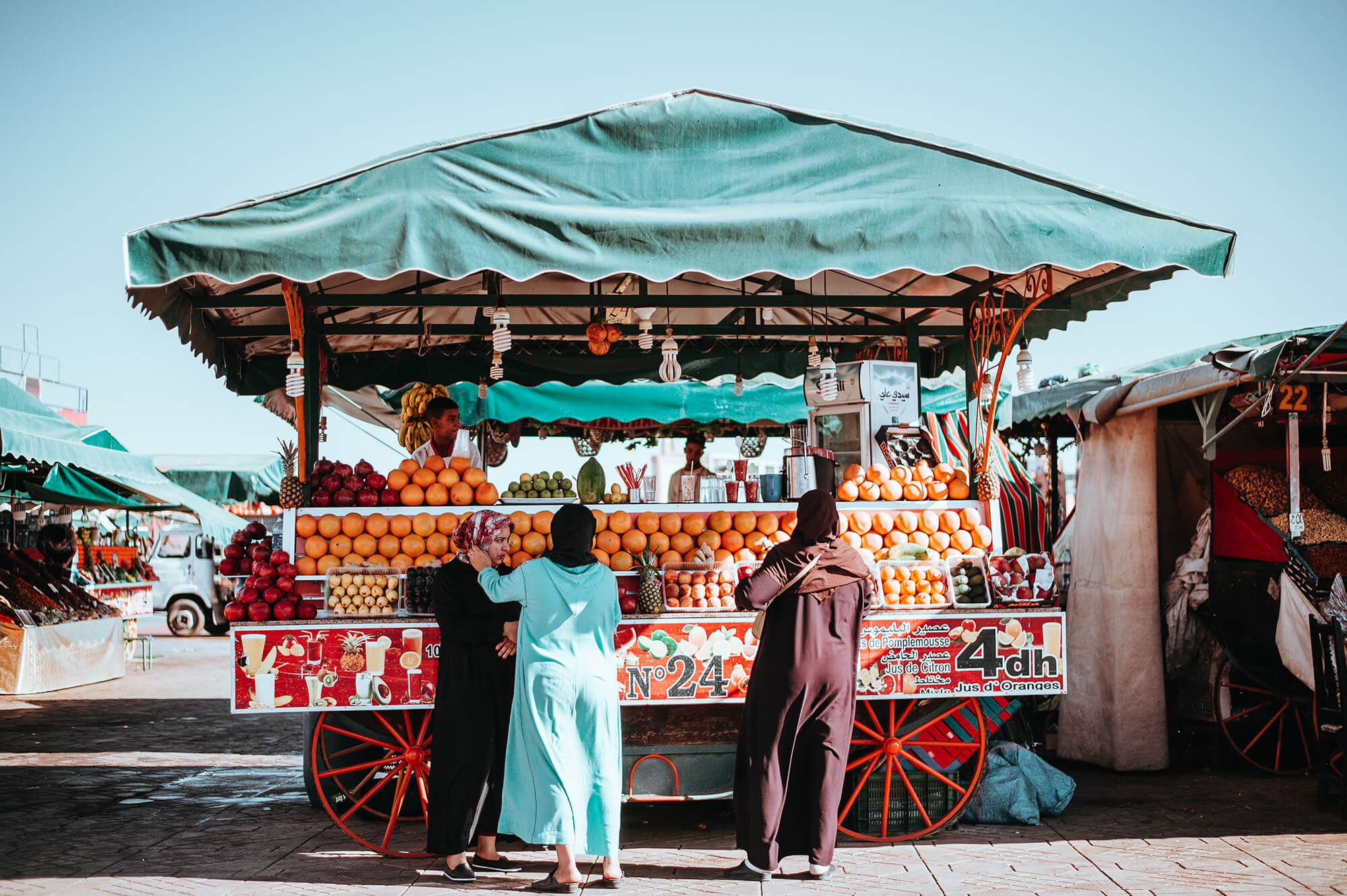
Moroccan food is more than flavor — it’s tradition, warmth, and community. Many Morocco tours include cooking classes where you can learn to make tagine or couscous from local chefs. As Moroccan cuisine continues to evolve, it remains one of the most vibrant, inviting, and delicious in the world.
🧭 FAQs
Q1: Is Moroccan food spicy?
Not usually. Moroccan cuisine focuses more on rich aromas and balanced flavors than on heat. Spices such as cumin, paprika, cinnamon, turmeric, and ginger create depth and warmth rather than sharp spiciness. You can always ask for mild options if you prefer less spice.
Q2: What is Morocco’s most famous dish?
The tagine is Morocco’s most iconic dish. It’s a slow-cooked stew of meat, vegetables, and spices prepared in a conical clay pot that keeps the food tender and flavorful. Chicken with preserved lemons and olives or lamb with prunes are especially popular.
Q3: What do Moroccans eat for breakfast?
Breakfasts in Morocco are light but flavorful, typically including fresh bread such as khobz or msemmen, with olive oil, jam, or honey. Mint tea or coffee is always served, sometimes alongside cheese, boiled eggs, or fresh orange juice.
Q4:Is Moroccan food healthy?
Yes. Moroccan food is based on fresh vegetables, grains, legumes, and lean meats, cooked with olive oil and natural spices. Many dishes, like couscous or zaalouk, are nutrient-rich and balanced, making Moroccan cuisine one of the healthiest in North Africa.
Q5: Can vegetarians eat well in Morocco?
Definitely. While Morocco is known for its meat dishes, many options are vegetarian-friendly. You can enjoy vegetable tagines, lentil soups, chickpea salads, and dishes like bissara (fava bean soup) and zaalouk (eggplant salad).
Q6: What drinks are popular in Morocco?
The most popular drink is traditional Moroccan mint tea — sweet, fragrant, and a symbol of hospitality. Other local favorites include almond milk, pomegranate juice, fresh orange juice, and strong Arabic coffee. Alcohol is available in tourist areas but not widely consumed publicly.
Q7: Is Moroccan food halal?
Yes. Almost all Moroccan meat dishes are prepared according to Islamic dietary laws, meaning they are halal. Pork is rarely served, but lamb, chicken, beef, and seafood are common and widely enjoyed.
Q8: Can tourists take Moroccan cooking classes?
Yes! Many Moroccan cities like Marrakech, Fes, and Essaouira offer hands-on cooking classes where visitors can learn to make tagines, couscous, or pastries with local chefs. You can even book a Moroccan tour package that includes culinary experiences.
—
Editor’s Note: This post was originally published in 2020 and updated in October 2025 for accuracy and freshness.


